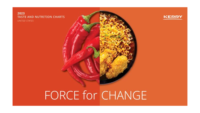Ready or not, it's 2024 time, so here's an overview of what protein market trends key industry stakeholders foresee steering market development in the coming year:
Baldor Specialty Foods
New York-based Baldor Specialty Foods is an importer and distributor of a broad line of specialty foods serving more than 13,000 restaurant, foodservice, retail and corporate accounts in the Northeast and Mid-Atlantic regions. Baldor curates more than 6,000 items — including meat, poultry, fish, dairy, produce and specialty items, with a focus on local, peak season and small farms. Baldor’s Hot List of specialty items the distributor has seen experience significant growth in recent months includes a lone animal protein — Buddhist fresh duck (with head and feet), up 118%. Baldor also sees its heritage breed proteins continuing to trend.
Culinary Visions
Culinary Visions, a food-focused trends forecasting practice sees five trends emerging:
- 76% of consumers surveyed considered themselves adventurous eaters both at home and in restaurants, with 84% saying they enjoy being creative with ingredients in the kitchen.
- As the line between foodservice and retail channels continues to blur, 71% of consumers surveyed found the idea of a box of groceries curated by a restaurant chef appealing, and 72% expressed interest in a restaurant chef and local farmer teaming up to create a meal kit.
- 79% of the consumers said that they wanted to know as much as possible about the food that they are eating, with nearly two-thirds (63%) saying they prefer to order menu items that tell them where the ingredients come from, specifying not just the country or region of origin, but specific farms. More than half (53%) said they have changed the restaurants they patronize based on how employees were treated post-pandemic.
- Knowledgeable in-store employees can create a sense of community among shoppers interested in learning more about their food purchases, with nearly three out of four (72%) saying having experts available in store to answer their questions on specific items makes the shopping trip worthwhile.
- 68% of consumers said that prepared sauces or flavoring components make home cooking easier, and 76% of consumers said they like to order takeout from restaurants for things that are difficult to make at home.
Midan Marketing
Midan’s annual Top Trends To Watch blog identifies some key areas for businesses to watch in 2024:
- The ongoing war between Russia and Ukraine has impacted the food supply, and the conflict between Israel and Palestine also has the potential to cause issues for food supplies. On the home front, Americans are more divided than ever about politics. This brings challenges for brands that don’t want their products associated with anger that can be rampant online, fueling a trend toward “mindful marketing,” a conscious approach where brands are intentional about not offending or alienating their audience.
- Ongoing inflation — while the annual inflation rate was lower in 2023 than the year before, consumers report feeling like prices just keep increasing.
- Private and store labels stay winning — this is true for both fresh meat and poultry as well as processed products like sausage and deli meat. In 2023, preference for private-label products hit its highest recorded point in 16 years of retail data, while preference for national brands was at its lowest point since 2016 for both fresh and processed meat products. Consumers are concentrating on essentials right now, with almost half (46%) of shoppers reporting they focus on specific pre-planned items when grocery shopping and avoiding impulse shopping. This is a signal to the meat industry to focus on affordable meat staples like ground beef.
- Beef has been flat and inching toward constriction in recent months due to drought conditions and higher feed costs. USDA reports broiler production will be slightly reduced in 2024 compared to 2023 due to weaker prices and lower imports and exports. With plenty of pork in the pipeline going into 2024, there is a significant opportunity for the pork industry. The right on-pack claims and marketing messaging along with an educated retail staff can help showcase pork’s benefits.
- Sales of plant-based meat alternatives remained flat in 2023, as consumers declined to give up the flavor and texture of real meat long term for the purported benefits of the alt-meat products. The category has enough of a following that the meat industry can’t simply ignore the trend.
- The number of consumers who say they frequently purchase value added meat has more than tripled since 2016. Last year, value added sales for beef alone grew more than 25% since 2019, and 29% of meat consumers said any meat product that saves them time is worth paying extra for. Look for case-ready products to continue to rule the meat case: In 2022, 83% of the meat case was case ready – up from only 66% in 2010.
- Sustainability’s definition will continue to evolve, and right now regenerative agriculture is getting a lot of buzz within the meat space.
Specialty Food Association
The Specialty Food Association recently unveiled its trends to watch for in 2024, and international flavors were a prominent theme. Brian Kempf, vice president of Culinary at Butler’s Pantry in St. Louis, said cell-based meat and seafood will move further toward the forefront in the months ahead. “While I believe cell-based food holds the potential to revolutionize meat production and consumption, there are significant industry challenges to overcome,” Kempf said, adding that questions regarding allergies, cross-contamination and regulatory gaps still exist.”
Technomic
We’ve seen the influence of Mexican and Italian cuisines on burgers, but the future of globally inspired burgers points to the inclusion of ingredients such as kimchi, gochujang, Sriracha and hoisin. Like many other menu categories, Asian food and flavor infusions are making noticeable inroads for burgers Look for increased focus on pan-Asian flavors for burgers.

.png?height=96&t=1647275041&width=96)



Report Abusive Comment